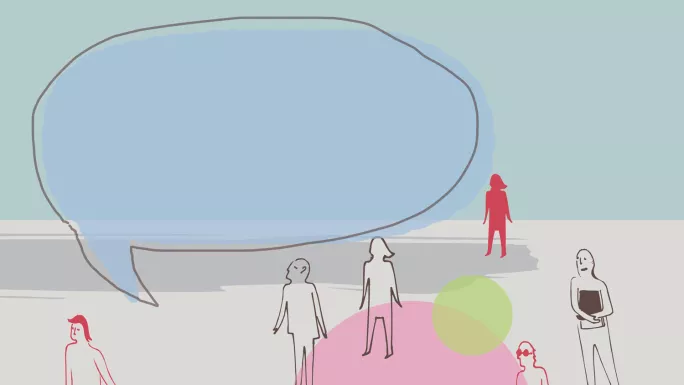The carefully worded welcome

Imagine being the leader of a local authority and being told that you suddenly need to deal with an influx of 100,000 men, women and children into your city, and that most of them will not be able to speak the local language.
Now imagine you are in charge of education provision in that city and you need to integrate a large number of these children into your education system. What would you do? How would you best meet the needs of these children while continuing to maintain a high standard of education for the children currently in your schools?
This was the challenge facing Berlin City Council last year. In Britain, we looked on as refugees fleeing Syria and other war-ravaged countries arrived in Germany to open arms, yet we never fully gained an insight into how they were integrated into German society.
Last summer, I travelled to Berlin as part of an Erasmus+ scheme to find out. There I met Gudrun Schreier, whose job it is to oversee the integration of thousands of refugee children into the city’s education system.
How Schreier and her team approached their task should be of interest to schools everywhere - it is a task many of us will soon have to undertake, too.
Schreier was guided by the overall approach of the council. The underlying principle it adopted was Sprache als Schlüssel zur Integration (language as the key to integration). In a school setting, this took the form of Willkommensklassen (welcome classes).

Willkommensklassen are special classes within a school, made up purely of nonnative speaking children who initially have little or no knowledge of German. They are situated within mainstream schools, with language acquisition being their principal function.
The goal of the Willkommensklassen is that within six to 12 months, 90 per cent of the children will have obtained a high enough standard of German to be able to transfer to a Regelklasse (mainstream class).
As of July 2016, there were 1,004 Willkommensklassen in Berlin and a total of 12,191 children in such classes. Of that number, approximately 50 per cent were primary-aged children. Here’s how the system works.
Selection
Not all children with refugee status are filtered into Willkommensklassen. Children under the age of 8 go directly into mainstream settings as the council decided the first two years of formal German schooling would be accessible to these students and also fertile places for language acquisition to take place.
Likewise, children who have sufficient German language skills also go straight into the mainstream and pick up support via the regular learning support mechanisms within a school.
The level of language knowledge a child has is assessed soon after a family arrives in the country. Every individual must register with the district authority and, as part of the registration processes, all children then receive a medical examination and a language test. This test determines their school destination.
Allocation
Schreier explains that she holds a meeting at the beginning of each month and reviews the number of refugee children who have recently arrived in Berlin and where they are living. Then, in cooperation with the 12 Berlin district authorities, they identify the school places required in each district and identify the schools that have space in which a Willkommensklasse can be established.
The schools are then informed that one or more Willkommensklassen will be set up in their school and the city council ensures that the physical requirements for the classes are met. Teaching staff are then recruited. It is possible to establish such classes within a couple of weeks of the initial meeting.
Schreier points out that teachers themselves were the main driving force behind the provision of Willkommensklassen for newly arrived non-German speaking children. The idea of such classes is not new in Berlin and similar classes existed between 1971 and 2007. From 2007, language acquisition was intended to take place within Regelklassen and schools were given additional support. However, as the numbers of non-German speaking children coming to Berlin began to rise, teachers in Regelklassen began to argue that the ad hoc arrival of such children placed too many pressures on them.
Teachers felt that they were inadequately resourced to meet the needs of such children and at the same time to maintain education standards for existing class members. For this reason, Willkommensklassen were reintroduced in 2011.
Content and structure
In terms of how the Willkommensklassen operate, a great deal of freedom is given to individual schools. It is not intended for children attending Willkommensklassen to be isolated from other German speaking children within a school: rather it is expected that they would attend Regelklassen for lessons such as music and PE, and they would also mix with other children during break times and after school activities.
The school decides what is taught in the Willkommensklasse and which lessons a child will attend in Regelklasse. The only stipulation is that language teaching is the priority and the school determines when a child has reached a sufficient level of German to transition full-time to a mainstream class. The classes have a pupil teacher ratio of 12:1 and the teachers of such classes have obtained, or are working on gaining, a specific qualification in teaching German as a second language.
Support
The Berlin City Council has expanded the support it offers to schools in terms of access to psychological services and general social services support. In addition, the Berlin Zentrum für Sprachbildung (Centre for Language Education) is now offering a much extended range of training to teachers to help them identify and meet the education needs of the new arrivals.
Refugee children receive free travel passes, free school meals and financial support to purchase school materials. Furthermore, Ferienschulen (holiday schools) have been set up during school vacations so that children can continue to have opportunities to improve their German throughout the year.
Impact
The empowerment of individuals and local schools as part of the Willkommensklassen process has allowed Berlin to respond quickly, and in the vast majority of cases effectively, to the educational needs of the newly arrived children. Excellent examples exist of well-functioning Willkommensklassen, linked closely to the rest of the school, that are providing quality language teaching and a seamless progression of children into mainstream classes.
However, those involved in German education are fully aware that problems exist. There have been difficulties in finding enough suitably trained teachers. There is no clear central oversight and, as such, there is at present no way of being certain of the quality of education being provided.
The teachers themselves report that a minority of schools are not demonstrating a commitment to integrating refugee children into the life of the school. School overcrowding can also mean that when a child has achieved a level of German that would enable them to progress to a mainstream class, there is no available place for them in the school.
People may feel that Willkommensklassen are a form of segregation and are not in the best interests of the children. However, I believe that Willkommensklassen, combined with the professionalism of German teachers, are about meeting the needs of all the children within the Berlin education system - and we should look to see what lessons we can learn.
Alexander O’Mahoney is a primary school teacher in Dublin. His Berlin trip was funded by the Erasmus+ programme
You need a Tes subscription to read this article
Subscribe now to read this article and get other subscriber-only content:
- Unlimited access to all Tes magazine content
- Exclusive subscriber-only stories
- Award-winning email newsletters
Already a subscriber? Log in
You need a subscription to read this article
Subscribe now to read this article and get other subscriber-only content, including:
- Unlimited access to all Tes magazine content
- Exclusive subscriber-only stories
- Award-winning email newsletters